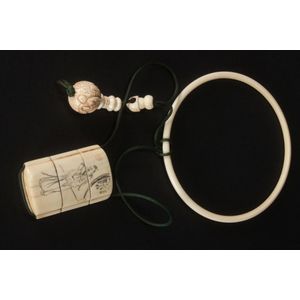Meiji Ivory Inro and Ojime with Scholar and Bird
Japanese Meiji period ivory Inro and ojime, the three compartment inro carved with scholar to one side, with bird on flowering branch to the other side, signed, length 4 cm, the ojime carved with figures, all suspended from an ivory ring diameter 7 cm
You must be a subscriber, and be logged in to view price and dealer details.
Subscribe Now to view actual auction price for this item
When you subscribe, you have the option of setting the currency in which to display prices to $Au, $US, $NZ or Stg.
This item has been sold, and the description, image and price are for reference purposes only.
- Ivory - Ivory is a hard white material that comes from the tusks of elephants, mammoth, walrus and boar, or from the teeth of hippopotamus and whales. The ivory from the African elephant is the most prized source of ivory. Although the mammoth is extinct, tusks are still being unearthed in Russia and offered for sale.
Ivory has been used since the earliest times as a material for sculpture of small items, both in Europe and the east, principally China and Japan.
In Asia ivory has been carved for netsuke, seals, okimono, card cases, fan supports, animals and other figures and even as carved tusks.
In the last 200 years in Europe ivory has been used to carve figures, for elaborate tankards, snuff boxes, cane handles, embroidery and sewing accessories, in jewellery and as inlay on furniture. Its more practical uses include being used for billiard balls, buttons, and a veneers on the top of piano keys.
The use and trade of elephant ivory have become controversial because they have contributed to Due to the decline in elephant populations because of the trade in ivory, the Asian elephant was placed on Appendix One of the Convention on International Trade in Endangered Species (CITES), in 1975, and in January 1990, the African elephant was similarly listed. Under Appendix One, international trade in Asian or African elephant ivory between member countries is forbidden. Unlike trade in elephant tusks, trade in mammoth tusks is legal.
Since the invention of plastics, there have been many attempts to create an artificial ivory - Ojime - An ojime is a small decorative bead that is used as a sliding bead or toggle on the cord of a traditional Japanese netsuke. The netsuke is a small sculptural object that was used to fasten a container, such as a box or pouch, to the obi (sash) worn with a traditional Japanese kimono.
The ojime was used to adjust the length of the cord or to secure the container in place. Ojime beads were typically made from a variety of materials such as wood, ivory, bone, and stone. They were often elaborately carved with intricate designs or decorated with colourful lacquer, enamel, or inlay work.
This item has been included into following indexes:
Visually similar items

9ct gold bangle, approx. 21.5gr
Sold by
in
for
You can display prices in $Au, $US, $NZ or Stg.

Scandinavian sterling silver necklace circa 1940s marked Berf 925, 40 cm long
Sold by
in
for
You can display prices in $Au, $US, $NZ or Stg.

Sold by
in
for
You can display prices in $Au, $US, $NZ or Stg.

Japanese ivory three section inro. Carved horse to each side, with three ivory beads attached. Provenance: Private Collection, ACT. Height 5 cm
Sold by
in
for
You can display prices in $Au, $US, $NZ or Stg.
